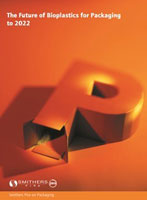Global bioplastics for packaging market to grow by 17% to 2022; Asia in the lead

The global bioplastics for packaging industry is forecast to grow from 2017-2022 at an annual average rate of 17% to a market value of almost US$7.2 billion according to new research from Smithers Pira.
The firm also says that in terms of geographical development, though Europe is the largest regional market for bioplastic packaging with a 31% share of the global bioplastic packaging consumption and accounts for a majority of R&D work, it will account for less than 10% of bioplastic production capacity and a have a diminishing share of bioplastic packaging consumption by 2022. Most of the currently planned volume production facilities are being implemented in Thailand, India and China, and over three-quarters of bioplastics will be produced in Asia by 2022.
According to Smithers Pira’s new report –– The Future of Bioplastics for Packaging to 2022 [http://www.smitherspira.com/industry-market-reports/packaging/the-future-of-bioplastics-for-packaging-to-2022] –– bioplastics for packaging markets currently represent a very small share of the global plastic packaging market value, but it will grow very strongly – more than doubling in value across the forecast period.
Furthermore in packaging applications where it is technically possible for bioplastics to replace oil-based polymers, suppliers will also have to manage the problems of higher production costs, capital availability, and limited availability of bio-based feedstock over the coming years.
Vlad Savinov, author of the report, comments: “While the potential market for bioplastics is huge, consumption rates will depend on whether producers can grow their production capabilities fast enough and at acceptable cost/performance levels to meet demand. Decades ago, the oil refinery and petrochemical industry successfully implemented the use of added-value business models.”
He adds, “These business models generated high levels of profit by integrating the supply chain from the oil well head all the way through chemicals and polymer production. This allowed producers to operate an integrated raw material and polymer complex with very few middle-men and therefore captured profit at each level of the supply chain. It is expected that the biopolymer sector will adapt an added-value business model in a similar way. Unlike oil refineries, a bio-refinery will be capable of processing many different types of biomass, including sugars, cellulose and various plant oils.”
In the future, the development of new technologies will ensure the emergence of new types of polymers and improved ways of producing currently available biopolymers for various end-use applications. Future biopolymers will offer improved rates of biorenewability and biodegradability, as this rate is an important factor in achieving market acceptance.
In terms of end-use categories, non-food is the largest area of application for bioplastic packaging in 2017, accounting for almost 46% of global consumption. This reflects significant bioplastics consumption for garbage bags and carry-out bags. Food is the second largest end-use sector, followed by beverage bottles. Bioplastic beverage bottle consumption has grown dramatically since 2012, following the introduction of bio-derived PET for soft drinks bottles, and will account for almost 22% of bioplastics for packaging consumption in 2017.
The report is based on a combination of in-depth primary and secondary research. Primary research included refinement of Smithers Pira’s databases on bioplastic packaging throughout the world and interviews targeting key decision makers.
(PRA)Copyright (c) 2017 www.plasticsandrubberasia.com. All rights reserved.



















































